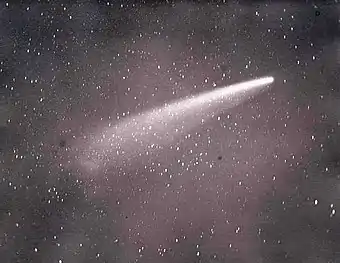1882 in science
The year 1882 in science and technology involved some significant events, listed below.
| |||
|---|---|---|---|
|
Astronomy
- September – Great Comet of 1882 sighted.[1]
- December 6 – Transit of Venus, 1882.

Great Comet as seen from Cape Town by David Gill
Biology
- March 24 – Robert Koch announces his discovery of the bacterium responsible for tuberculosis, Mycobacterium tuberculosis.
- Élie Metchnikoff discovers phagocytosis.[2]
Chemistry
- Italian physicist Luigi Palmieri detects helium on Earth for the first time through its D3 spectral line when he analyzes the lava of Mount Vesuvius.[3]
Earth sciences
- Clarence Dutton's Tertiary History of the Grand Cañon District is published by the United States Geological Survey.
Mathematics
- June – German mathematician Ferdinand von Lindemann publishes proof that π is a transcendental number and that squaring the circle is consequently impossible.[4][5]
- December – Swedish mathematician Gösta Mittag-Leffler establishes the journal Acta Mathematica.
- Felix Klein first describes the Klein bottle.
Medicine
- March 28 – Paul Beiersdorf patents an adhesive bandage in Germany, the foundation of the Beiersdorf company.
- Vladimir Bekhterev publishes Provodiashchie puti mozga ("The Conduction Paths in the Brain and Spinal Cord"), beginning to note the role of the hippocampus in memory.
Technology
- January 12 – Holborn Viaduct power station in the City of London, the world's first coal-fired public electricity generating station, begins operation.[6]
- By March – Étienne-Jules Marey invents a chronophotographic gun capable of photographing 12 consecutive frames per second on the same plate.
- April 29 – Werner von Siemens demonstrates his Electromote, the first form of trolleybus, in Berlin.
- June 6 – Henry W. Seeley patents the electric clothes iron in the United States.[7]
- September 4 – Thomas Edison starts the United States' first commercial electrical power plant, lighting one square mile of lower Manhattan.
- English mechanical engineer James Atkinson invents his "Differential Engine".
- American electrical engineer Schuyler Wheeler produces an electric fan.
- Alfred P. Southwick publishes his proposals for use of the electric chair as an execution method in the United States.
Events
- First International Polar Year, an international scientific program, begins.
- The Chartered Institute of Patent Agents, the modern-day Chartered Institute of Patent Attorneys, is founded in the United Kingdom.
Awards
- Copley Medal: Arthur Cayley[8]
- Wollaston Medal for Geology: Franz Ritter von Hauer
Births
- March 14 – Wacław Sierpiński (died 1969), Polish mathematician.
- March 23 – Emmy Noether (died 1935), German mathematician.
- March 30 – Melanie Klein (died 1960), Viennese-born psychoanalyst.
- June 17 – Harold Gillies (died 1960), New Zealand-born plastic surgeon.
- July 12 – Traian Lalescu (died 1929), Romanian mathematician.
- July 21 – Herbert E. Ives (died 1953), American optical engineer.
- September 30 – Hans Geiger (died 1945), German inventor of the Geiger counter.
- October 5 – Robert Goddard (died 1945), American rocket scientist.
- October 26 – Marietta Pallis (died 1963), Indian-born Graeco-British ecologist.
- November 18 – Frances Gertrude McGill (died 1959), pioneering Canadian forensic pathologist.
- December 11 – Max Born (died 1970), German physicist and recipient of the Nobel Prize in physics in 1954.
- December 28 – Arthur Eddington (died 1944), English astrophysicist.
- Israel Aharoni (died 1946), Belarusian-born Jewish zoologist.
Deaths
- January 11 – Theodor Schwann (born 1810), German physiologist.
- April 19 – Charles Darwin (born 1809), English naturalist and geologist.
- August 24 – John Dillwyn Llewelyn (born 1810), Welsh botanist and photographer.
- September 23 – Friedrich Wöhler (born 1800), German chemist.
- October 27 – Christian Heinrich von Nagel (born 1803), German geometer.
- November 20 – Henry Draper (born 1837), doctor, American astronomer.
- December 24
- Johann Benedict Listing (born 1808), German mathematician.
- Charles Vincent Walker (born 1812), English telegraph engineer.
References
- Plummer, William Edward (March 1889). "The great comet of September 1882". The Observatory. 12: 140–142. Bibcode:1889Obs....12..140P.
- Petrunkevitch, Alexander (1920). "Russia's Contribution to Science". Transactions of the Connecticut Academy of Arts and Sciences. 23: 239.
- Stewart, Alfred Walter (2008). Recent Advances in Physical and Inorganic Chemistry. BiblioBazaar, LLC. p. 201. ISBN 978-0-554-80513-9.
- Lindemann, F. (1882). "Über die Zahl π". Mathematische Annalen. 20: 213–225. doi:10.1007/BF01446522.
- Crilly, Tony (2007). 50 Mathematical Ideas you really need to know. London: Quercus. pp. 21, 81. ISBN 978-1-84724-008-8.
- Harris, Jack (1982-01-14). "The electricity of Holborn". New Scientist. London.
- Patent no. 259,054. "Household Amenities and Appliances: Timeline of Their Arrival". PartSelect. Retrieved 2012-01-25.
- "Copley Medal | British scientific award". Encyclopedia Britannica. Retrieved 23 July 2020.
This article is issued from Wikipedia. The text is licensed under Creative Commons - Attribution - Sharealike. Additional terms may apply for the media files.
